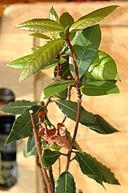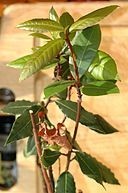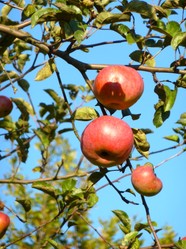Growing Bay Leaf.
The bay laurel, otherwise known as laurus nobilis, sweet bay or bay tree, is a fragrant evergreen which originated in the Northern Mediterranean. The leaves from the bay tree are used extensively in cooking to flavor soups, stews and an array of different dishes.
In addition, this aromatic herb is known to possess antiseptic and antioxidant properties as well as containing high levels of vitamin A and C, Calcium, Copper, Potassium, Magnesium, Iron, Selenium and Zinc. Given these benefits, it is hardly suprising that growing bay laurel leaves at home for a supply 'on tap' is becoming increasingly popular.









 A Colorful Journey: Comparing and Contrasting Mexican Folk Art With Polish Folk Arton 09/05/2024
A Colorful Journey: Comparing and Contrasting Mexican Folk Art With Polish Folk Arton 09/05/2024
 Exploring Traditional Japanese Tapestry Landscape Art: A Window into Nature’s Serenityon 09/01/2024
Exploring Traditional Japanese Tapestry Landscape Art: A Window into Nature’s Serenityon 09/01/2024
 Are Border Collies Really the Smartest Dog Breed?on 08/20/2024
Are Border Collies Really the Smartest Dog Breed?on 08/20/2024
 A Writer's Guide To Wizzley- A Gem of A Bookon 04/10/2013
A Writer's Guide To Wizzley- A Gem of A Bookon 04/10/2013



Comments
Hi DerdriuMarriner,
I think reflective light could work well but I didn't consider this for my own plant. I placed my Bay Laurel (which was very old and sadly died a few years ago) in a position where it received some direct sunlight throughout the day albeit only for an hour or two but was still a fairly bright spot when not in direct sunlight. I know many urban gardeners have had great success using reflective light when growing indoors in containers and I think bay laurel plants could do well with this method, although I have not tried it myself.
The second subheading, Growing bay laurel in containers, advises us that "your bay will still need adequate light so find a well lit position for your plant."
Do you find that direct or reflected or switching between direct and reflected light most supportive to healthy bay laurel indoors?
This was the most useful web article so far on planting & maintenance of the shrub. My in-ground sapling died last winter during ice storms, so even though I live in North Carolina, I am planting my new one in a container until it is pretty sturdy. I probably won't bring the container indoors during winter, but at least I can bring it closer to the house for protection.
I am very much intentionally growing the plant for the culinary use of the leaves.
Katie,
It's great to be able to pull some leaves off when you need them too. My mums always asking me to bring some round, she adds them to every soup and stew that she makes. :)
Now that my kids are older I'm interested in getting back into raising and enjoying indoor plants again. The bay laurel seems like a great starting point. Lovely bay tree. :)K
Mines indoors at the moment, Mira. It's too cold in the Uk to leave them outside in the winter. But as long as you put them in a nice sunny spot indoors, they'll do just as well as they do outdoors.
I would plant this if I had a garden :)
Hi 2uesday,
Mine is, lets say, very mature but was already well established when my grandfather gave it to me. As long as they're in a nice sunny position they thrive, so it's definitely worth buying small bays and growing them on.
Brenda, I've had mine getting on 25 years, it was my grandfather's plant and it's still going strong.
Bay laurel makes a lovely plant. I will have to remember this when I move back to
Southern California.